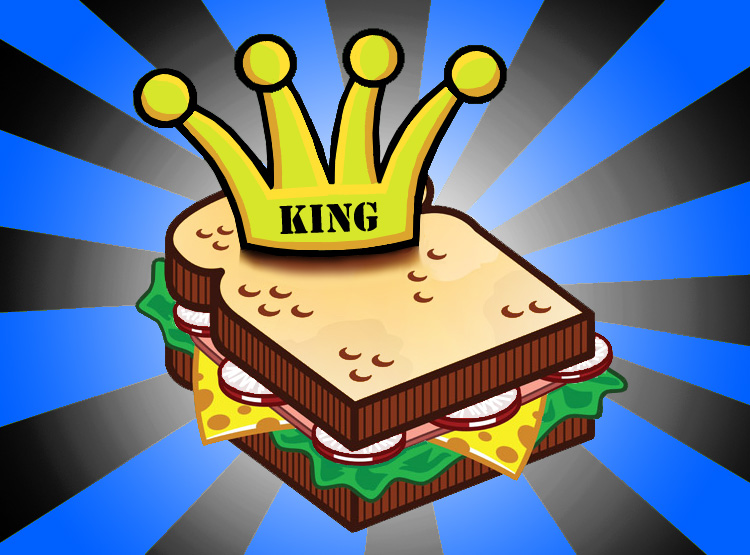Why are Sandwiches treated like Second Class food?
You’d think that Canadian and American culture would be more approving of sandwiches. Yet they receive hardly a mention in people’s psyche, a strange level of apathy, even worse than the the lowly hotdog. This madness has to stop!

In a land where the largest burger franchises dot the landscape more densely than cellphone towers, second only to coffee and donut outlets, you’d expect to see more serious sandwiches. It might even seem like irony that Arby’s has proven that you can indeed sell non-burger sandwiches as meals, but even those are centered around a huge serving of meat, which seems to be much of the attraction to burgers. They appeal to that core belief that many people hold, consciously or not, that meat has more value than other foods.
The rise of shawarma places, or similar ones opting for a flatbread wrapping, may also have a lot to do with the image. They are still considered ethnic foods, even though the ingredients can be pretty ordinary, roast chicken, cabbage, onion, hot sauce, etc. That slight distinction, may blur people’s perception, that these are in fact also sandwiches, so it’s ok; like how owning a cross-over vehicle is trendy, yet a station wagon is unacceptable, when the only real difference is ride height.
Still, the burger seems to be the only culturally acceptable form of domestic dinner sandwich.
If we zip across the Atlantic ocean, we find the old world doesn’t share this view. Possibly, their view is the exact opposite. The french idea of a picnic, with a lovely baguette, miscellaneous fresh vegetables, and a few bottles of wine, would qualify for pretty much any meal. Even dinner, although no one would mistake you for a social elite for downing half a loaf of buttered crusty bread with soup, it is nevertheless not a social crime. The further east you go, the more sandwiches become the norm too.
Perhaps this phenomenon is similar to how Americans buy cars, by the yard. Almost like the old world is too concerned with frugality, to cramped for space, and everything costs too much, so the answer is to rebel against those notions. Why buy a 1.4L diesel engined compact car, when you can buy 20 feet of hulking steel, in the form of a pickup truck, for the same price? Which translates to: why buy some bread, with various healthy greens and stinky cheese, when you can buy a slab of meat, with sauce and bread on it?
With seemingly endless expanses of land to steal from the natives, perhaps greedy eyes were inevitably going to shape the culture.
Interestingly, England may be the only European country (or region if we include the other islands) that doesn’t appreciate fresh food. Most of their cooking would look at home in a Shakespearean scene involving witches, and a boiling cauldron of goop. Everyone has probably heard of haggis, that overcooked sack of meat and strong herbs, a delicacy in Scotland, and it really is as awful as it sounds. Most of the other dishes are mild improvements.
It’s probably no wonder then, that the Indian invasion over the past 2-3 decades, which has brought with it many spices, has almost entirely supplanted tasteless English cuisine. The most popular dish in England today is chicken curry. I quite like Indian food myself, though I can never remember the names, partly because I also eat Pakistani foods about as often, and the two are very easy to confuse.
Thing is, you are meant to eat their kind of food in groups, with many varied dishes providing a kind of home buffet, but in many ways Indian food is like catering, not individually meal quality. To the English, who would like to fancy themselves as upper crust, descendants of aristocracy, fourteenth cousin’s of famous Barons, and so on, this must seem almost like slumming it.
Makes you wonder if they treat it like a guilty pleasure, rather than food.
The other notable difference in the old world is cost, everything costs a lot, especially meat. Places like Switzerland have quite a lot of goats, and a fair few sheep, but they aren’t considered livestock to butcher, so they end up having to import almost all their butcher meat. And if you’ve ever looked into how the Swiss live, you’ll see they are mostly scattered between mountains, often in small villages, sometimes in nothing more than hamlets. That scene in The Sound of Music, where the woman is spinning herself, all you can see is green pastures, mountains, and occasional furry white dots; that’s a pretty good representation. Imagine shipping costs, ugh.
Eastern Europe is another matter entirely. There were always lots of sheep, pigs, horses, and other farm animals happy to live in hilly country, with the domestic cow being the rarity. This may also have indirectly contributed to the mindset of not wasting anything, because pigs and sheep by percentage, yield a lot more than a cow. Raising cows for slaughter is inefficient, at least using traditional farming methods; it only starts to make sense in the much-maligned enclosed feedlots, as used in America, and as decried by PETA.
Yet the expense of raising livestock to kill for personal consumption was still high, which potentially meant selling off 2/3 of the baby pigs that popped out that year, just to cover the cost of raising the lot. Much of the regional cuisine took this into account, stews and soups were a very popular solution, a ribeye steak with mashed potatoes was not.
Eastern Europe also has a hearty agricultural basin, stretching from northern Italy, to Ukraine, it was generally able to supply the bulk of non-dairy foods to central Europe, and all the way to the Ural mountains in Russia. It wasn’t really until the World Wars that everyone compartmentalized production. Ironically, a line of salami in Hungary was born, made from the meat of overworked horses, and mules, which became quite a national treasure. See, no waste.
Even so, the area is very fertile, and it is reflected in the types of ingredients used in the dishes, everything from heavy root vegetables, to lighter leafy greens. Poppies grow in such abundance, that flying over the countrysides at the right time of year, might resemble impressionist paintings in vivid red. Tasty sweet peppers come in unusual pale lime, and range every shade between blood red, to forest green. Cabbages, lettuce, sprouts, onions, mushrooms, and grasses like alfalfa, all come in many forms as well. All very nutritious.
As someone who spent a lot of time in Europe, this is one key component missing in the western diet, raw food.
In eastern Europe, and France, a sandwich qualifies as any meal of the day, and any snack. You’d think savouring your food, reveling in the freshness would be more universal around the westernized world, but somehow it isn’t. However, it’s the sandwiches that make the fresh produce really pop, not in a salad distorted by over-powering dressings.
A breakfast sandwich might consist of as little as thin slices of toasted light rye bread, with a slathering of butter, and a large chunk of green pepper, sweet or hot. The next piece of bread might get a slice of smoked bacon, or a layer of soft cheese, perhaps blue or goat. Bread slices are kept deliberately small, the purpose isn’t to consume bread after all, but use it as a way to divide each bite from the last. Soft boiled eggs also don’t need giant chunks of bread to smear on. Freshly boiled raw milk might accompany the sandwiches, or possibly tea. Breakfast isn’t meant to be heavy, just to keep you feeling full until your stomach wakes up.
Then around lunch, or early afternoon, the sandwiches get a little more serious, this is the first of two actual meals in the day. Here a sandwich isn’t so much a sandwich, as a buffet of breads, meats, cheeses, and produce. You’d be using the bread as a delivery vehicle for anything soft, or as a way of extending the "lifespan" of your meat, remember, it’s expensive. Hard-boiled eggs for portability, various deli meats, and a range of cheeses would be the core of this meal. The vegetables would be anything you can nibble on, or wolf down whole, like small tomatoes, onion, pickles, lettuce, various peppers. Your sandwich would be an open ended question, with the bread acting as bookends, to a story of delicious toppings thrown in your mouth haphazardly. But that could be the wine making it’s way around the table talking.
Ask any European, and they will tell you, there’s always bread at dinner. Not the pathetic dinner rolls that restaurants serve, but significant slabs, no one over there panics about gluten. Whether they are used to absorb the remnants of a creamy soup, or used as a makeshift spoon for a heavier stew, it’s there. The sandwich here is more of an instrument, again the bread isn’t the focus, just the opening and closing scenes of the meal anyway. However, it’s not unusual to serve a plate of cold cuts with bread, just like the lunchtime version, with some additional hot food like a meatloaf.
In fact, there’s hardly any excuse not to eat a sandwich when you’re hungry.
Naturally, most snacks involve sandwiches too, as will meals on-the-go. Savoury meats, with sweet veggies, and tart sauces will fill you up for hours, without spiking your sugar levels. That’s one of the long lost benefits of the old world diet, the fact that you aren’t hungry constantly. You’d be amazed at how long a piece of toast with goose liver paté on it will keep your stomach happy.
All the low-fat, high-sugar meal options in the west, lead directly to hunger, and more sugar cravings, making people eat more, making them fat. If the average XXXL sized North American lived in France, or Romania, for an extended period, they would solve half of their health problems, and lose a ton (or more) of weight. All because of the low-sugar food stuffs, that is, if they can keep their grubby fingers off the pastry.
That’s not even considering the nutritional hazards of bleaching the vitamins out of your groceries boiling them, adding carcinogens by deep frying, or introducing radiolytes into the foods by microwaving them. Eating raw food is really the best option.
So the key to a good sandwich is a little tasty bread, with an over-stuffed middle. And the healthiest sandwich is one that’s mostly fresh produce.
Isn’t it time sandwiches got some more respect?
Leave A Comment
You must be logged in to post a comment.

